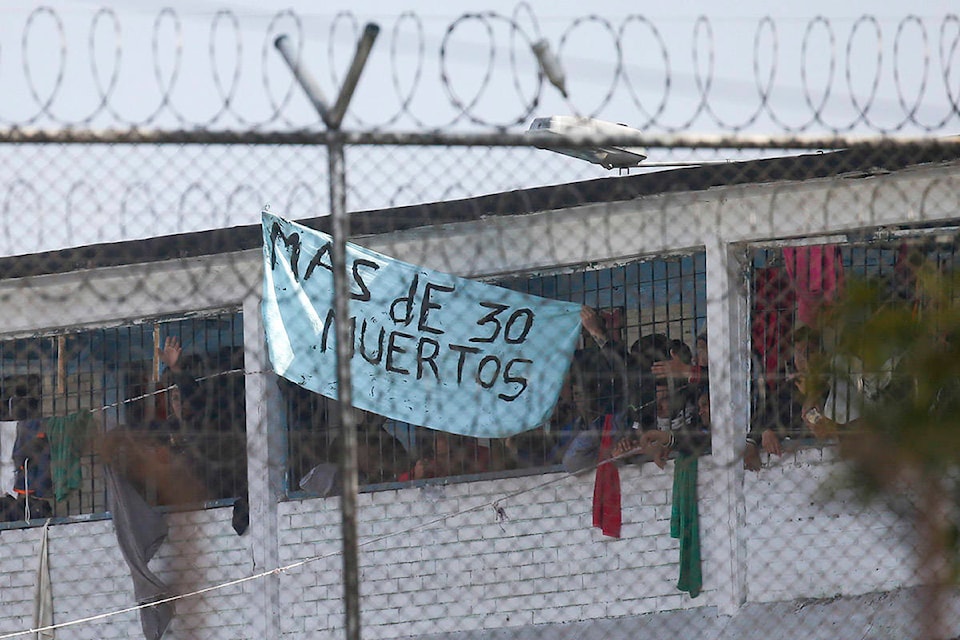Prisoners in the U.S. and parts of the U.K. could be released from jail early as the latest move by officials to prevent the spread of COVID-19.
Here in B.C, a group of Indigenous chiefs are joining a chorus of other advocates nationwide in calling for similar measures for non-violent offenders.
“Crisis reactions have allowed the most vulnerable people to be overlooked, and without immediate attention and drastic interventions, COVID-19 threatens the safety and well-being of incarcerated people across British Columbia and Canada,” the Union of BC Indian Chiefs said in a March 24 open letter to provincial and federal ministers.
“Over-crowding and insufficient sanitation could cause the virus to spread rapidly in correctional facilities, while insufficient medical and mental health resources increase its lethality.”
Jails act as ‘petri dishes’ for diseases, researcher says
Martha Paynter, a nurse who researches prisoner health as part of her doctoral studies at Dalhousie University in Halifax, said prisons and jails are “petri dishes” where disease spreads quickly and inmates can do little to isolate themselves for protection.
“People who are inside cannot easily get away from others – there is poor ventilation, little time outside and a lack of hygiene products,” she said. “It is considered contraband to have access to alcohol-based substances like hand sanitizer. They’re lucky to get a bar of soap. It’s terrifying.”
READ MORE: Indefinite solitary confinement in prisons unconstitutional
James Bloomfield, president of the Prairies region for the Union of Canadian Correctional Officers, said COVID-19 fear has crept inside the institutions.
“It gets pretty complicated when you start housing hundreds of people together,” he said. “We’re at the stage now where we’re trying to look at all of our protective equipment, gloves, masks, making sure we’ve got enough of that type of stuff, disinfectants.”
He said a constant flow of visitors, workers and medical staff make the institution vulnerable to infection.
“We can’t isolate everyone either,” he said from Winnipeg. “We’ve got 800 people at Stony Mountain (Institution) for example and when you start trying to isolate, it’s impossible.”
“If it does get in, we’re going to be bringing it home – the officers bringing it home to their families.”
Toronto criminal defence lawyer Daniel Brown said it’s only a matter of time before an inmate contracts the virus. He’s worried for his clients.
“There’s no way the jails can address the health concerns raised by a pandemic — they don’t have the facilities, they don’t have the ability to self-isolate,” he said. “Jails are overcrowded and underfunded. The staff aren’t equipped to deal with a crisis like this.”
There has not been a confirmed COVID-19 case inside a B.C. prison, as of March 26, but the group of First Nations leaders wants to see preventative action. Members fear inaction could be disproportionately felt by Indigenous people, who remain incarcerated at dramatically higher levels across the country.
In addition to releasing low-risk and non-violent offenders, Indigenous leaders want the federal government to create release plans for those nearing eligibility for parole or statutory release, as well as immediately decarcerate all Indigenous youth in custody wherever possible.
They also want corrections facilities to implement plans to treat inmates who contract the virus without relying on the over-use of solitary confinement.
Because most prisons have restricted access to visitors in order to curb the spread of the novel coronavirus, they also want the Correctional Service of Canada to provide free calling and video-calling access for all incarcerated people.
According to officials with Canada’s correctional services department, facilities have suspended all temporary absences of offenders unless medically necessary, work releases for offenders and all inter-regional and international transfers of inmates.
Alberta takes measures to keep prisoners safe
As officials around the globe work to control social contact to mitigate the spread of the virus while also keeping the peace, Italy has seen widespread unrest. On March 12, officials there announced 12 prisoners had died and 16 others escaped after a riot broke out in response to lockdown protocols which stopped or limited normal family visits. Forty guards were also injured.
A federal prison in central Alberta which houses 470 inmates was placed on lockdown earlier this month, out of precaution after a group for less than 10 inmates showed flu-like symptoms. They were tested for the novel coronavirus, and isolated as they awaited test results.
READ MORE: Reduce prison populations to fend against COVID-19 disaster, Alberta lawyers say
Since then, Alberta has allowed those sentenced to weekend jail time to self-isolate on house arrest and is assessing the possibility of youth offenders to also serve their sentence at home.
Prime Minister Justin Trudeau acknowledged this week that prisoners are at higher risk of contracting and spreading the virus, but did not say whether federal officials have been in contact with provinces about a nationwide plan.
In a statement to Black Press Media, the Correctional Service of Canada said officials “are examining what options are available to us in collaboration with the Parole Board of Canada and what flexibilities there are to safely release offenders into the community.”
The B.C. government did not respond to requests for comment by deadline. Earlier this month, it told Black Press Media that BC Corrections has been in daily pandemic planning meetings with the provincial correctional health service team, relating to cleaning schedules, intake and release procedures, along with educational and other programs for people in custody.
“We are building on the baseline of procedures and approaches developed in response to the previous H1N1 influenza.”
— With files from The Canadian Press
@ashwadhwani
ashley.wadhwani@bpdigital.ca
Like us on Facebook and follow us on Twitter.
